Transabdominal pre-peritoneal (TAPP) versus totally extraperitoneal (TEP) laparoscopic techniques for inguinal hernia repair
- PMID: 38963034
- PMCID: PMC11223180
- DOI: 10.1002/14651858.CD004703.pub3
Transabdominal pre-peritoneal (TAPP) versus totally extraperitoneal (TEP) laparoscopic techniques for inguinal hernia repair
Abstract
Background: An inguinal hernia occurs when part of the intestine protrudes through the abdominal muscles. In adults, this common condition is much more likely in men than in women. Inguinal hernia can be monitored by 'watchful waiting', but if symptoms persist or worsen, surgery is usually required, which can be open or laparoscopic. Laparoscopic (keyhole) repair of inguinal hernias in adults is generally performed using either the transabdominal preperitoneal (TAPP) or the totally extraperitoneal (TEP) method. Both methods include the use of mesh placed in front of the peritoneal lining of the abdominal wall, but for the TAPP technique, the abdominal cavity needs to be entered to place the mesh, and for the TEP technique, the whole procedure is done on the outside of the peritoneal lining of the abdominall wall. Whether one method is superior to the other has not been established, and there is debate about their relative benefits and harms. An advantage of TEP is its avoidance of the abdominal cavity; the downside is that it requires a steeper learning curve for clinicians. TAPP is considered simpler and makes it possible to inspect the contralateral side, but TAPP may have a higher risk of visceral injury compared to TEP. This is an update of a Cochrane review first published in 2005.
Objectives: To compare the benefits and harms of laparoscopic TAPP technique versus laparoscopic TEP technique for inguinal hernia repair in adults.
Search methods: On 25 October 2022, the authors searched the Cochrane Central Register of Controlled Trials (CENTRAL) in the Cochrane Library; Ovid MEDLINE(R) Epub Ahead of Print, In-Process & Other Non-Indexed Citations, Ovid MEDLINE(R) Daily, and Ovid MEDLINE(R); and Ovid Embase, for published randomised controlled trials. To identify studies in progress, we searched ClinicalTrials.gov and the WHO International Clinical Trial Registry Platform (ICTRP).
Selection criteria: All prospective randomised, quasi-randomised, and cluster-randomised trials that compared the laparoscopic TAPP technique with the laparoscopic TEP technique for inguinal hernia repair in adults were eligible for inclusion. We included studies that involved a mix of different types of groin hernia if we could extract data for the inguinal hernias. Studies may have also included a group of participants receiving hernia repair by open surgery, but these groups were not included in our review.
Data collection and analysis: Both review authors independently evaluated trial eligibility, extracted data from included studies, and assessed the risk of bias in the included studies. The review's primary outcomes were serious adverse events, chronic pain (persisting for at least six months after surgery), and hernia recurrence. We also assessed a variety of secondary outcomes at perioperative, early postoperative, and late postoperative time points. We performed statistical analyses using the random-effects model, and expressed the results as odds ratios (ORs) for dichotomous outcomes and mean differences (MDs) for continuous outcomes, with their respective 95% confidence intervals (CIs). We used GRADE to assess the certainty of evidence for key outcomes as high, moderate, low or very low.
Main results: We included 23 studies in this review update, which randomised 1156 people to TAPP and 1110 people to TEP, all requiring repair of inguinal hernias. Study sample sizes varied from 40 to 316 participants. The vast majority of study participants were male. We judged most studies to be at 'high' or 'unclear' risk of bias. Our judgements of the certainty of the evidence were low or very low for all outcomes we assessed. There may be little to no difference between TAPP and TEP laparoscopic techniques for serious adverse events (0.4% versus 0.7%; OR 0.58, 95% CI 0.15 to 2.32, P = 0.45, I2 = 0%; 19 studies, 1735 participants; low certainty of evidence); and hernia recurrence (1.2% versus 1.1%; OR 1.14, 95% CI 0.49 to 2.62, P = 0.97, I2 = 0%; 17 studies, 1712 participants; low certainty of evidence). The evidence is very uncertain about the effects of TAPP versus TEP techniques on chronic pain (OR 0.62, 95% CI 0.20 to 1.97, P = 0.68, I2 = 0%; 6 studies, 860 participants; very low certainty of evidence). In terms of secondary outcomes, the evidence is very uncertain for TAPP versus TEP techniques for perioperative visceral and vascular injury (15 studies, 1523 participants; very low certainty of evidence), and for haematoma or seroma during the early (≤ 30 days) postoperative phase (OR 0.86, 95% CI 0.54 to 1.37, P = 0.3861, I2 = 0%; 15 studies, 1423 participants; very low certainty of evidence). TEP technique may carry a higher risk of conversion to another hernia repair method (either TAPP technique or open surgery) when compared to TAPP (2.5% versus 0.7%; OR 0.28, 95% CI 0.09 to 0.84, P = 0.02, I2 = 0%; 13 studies, 1178 participants; low certainty of evidence). Only two studies (474 participants) reported quality of life in the late (> 30 days) postoperative phase; overall, there was an improvement in quality of life from the pre- to post-operative assessment, but the evidence suggests little to no difference between the techniques (low certainty of evidence).
Authors' conclusions: This review update found that there may be little to no difference between the TAPP and TEP techniques for serious adverse events, hernia recurrence, or chronic pain (low- to very-low-certainty evidence). Decisions about which method to use will most likely reflect surgeon and patient preference until high-certainty evidence becomes available. There may be a higher risk of needing to convert from TEP to TAPP or open surgery when compared to the risk of needing to convert from TAPP to open surgery (low-certainty evidence). If surgeons opt for TEP as their standard laparoscopic method, they could consider having a strategy for how to handle the potential need for conversion. This might include proficiency in the TAPP approach or having informed the patient about the risk of conversion to open surgery. For surgeons or surgical departments, the choice of a laparoscopic technique should involve shared decision-making with patients and their families or carers. Future research could focus on patient-reported outcomes, such as quality of life.
Copyright © 2024 The Cochrane Collaboration. Published by John Wiley & Sons, Ltd.
Conflict of interest statement
KA: no relevant interests. KA is a surgical resident at Herlev Hospital, Denmark, and Managing Editor of Cochrane Colorectal, but he was not involved in the editorial processing of this review update.
JR: no relevant interests. JR is a surgeon at Herlev Hospital, Denmark, and Co‐ordinating Editor of Cochrane Colorectal, but he was not involved in the editorial processing of this review update.
Figures
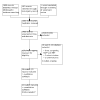


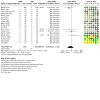
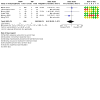
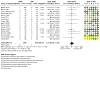
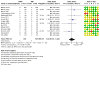
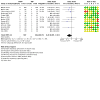
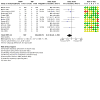
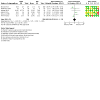
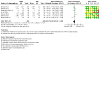
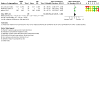
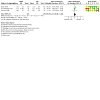
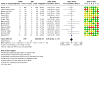
Update of
-
Transabdominal pre-peritoneal (TAPP) vs totally extraperitoneal (TEP) laparoscopic techniques for inguinal hernia repair.Cochrane Database Syst Rev. 2005 Jan 25;2005(1):CD004703. doi: 10.1002/14651858.CD004703.pub2. Cochrane Database Syst Rev. 2005. Update in: Cochrane Database Syst Rev. 2024 Jul 4;7:CD004703. doi: 10.1002/14651858.CD004703.pub3. PMID: 15674961 Free PMC article. Updated.
References
References to studies included in this review
Asuri 2021 {published data only}
-
- Asuri A, Misra M. Randomized comparison of testicular function, sexual function and quality of life following TEP and TAPP inguinal hernia repair. In: Surgical Endoscopy. Vol. 32. 2018:S430-82.
-
- Asuri K, Mohammad A, Prajapati OP, Sagar R, Kumar A, Sharma M, et al. A prospective randomized comparison of sexual function and semen analysis following laparoscopic totally extraperitoneal (TEP) and transabdominal pre-peritoneal (TAPP) inguinal hernia repair. Surgical Endoscopy 2021;35(6):2936-41. - PubMed
-
- Bansal VK, Mohammad A. A prospective randomized comparison of testicular function, sexual function and quality of life following laparascopic totally extra peritoneal (TEP) and trans abdominal pre peritoneal (TAPP) inguinal hernia repair [CTRI/2018/05/013621]. Clinical Trial Register - India (first received 2 May 2018);ctri.nic.in/Clinicaltrials/pmaindet2.php?EncHid=MTI1NjI=&Enc=&us.... [CTRI: 2018/05/013621]
Bansal 2013 {published data only}
-
- Bansal VK, Kumar S, Krishna A. A prospective randomized study comparing laparoscopic totally extra peritoneal (TEP) repair versus trans abdominal pre-peritoneal (TAPP) repair for inguinal hernia repair. In: Surgical Endoscopy and Other Interventional Techniques. Vol. 24. 2010:S616-7.
-
- Bansal VK, Misra MC, Babu D, Victor J, Kumar S, Sagar R, et al. A prospective, randomized comparison of long-term outcomes: chronic groin pain and quality of life following totally extraperitoneal (TEP) and transabdominal preperitoneal (TAPP) laparoscopic inguinal hernia repair. Surgical Endoscopy and Other Interventional Techniques 2013;27(7):2373-82. - PubMed
-
- Bansal VK, Misra MC, Krishna A, Jonathan V, Kumar S, Rajeshwari S, et al. Randomized comparison of chronic groin pain and quality of life after TEP and TAPP repair. In: Surgical Endoscopy and Other Interventional Techniques. Vol. 27. 2013:S9. - PubMed
-
- Krishna A, Misra MC, Bansal VK, Kumar S, Rajeshwari S, Chabra A. Laparoscopic inguinal hernia repair: transabdominal preperitoneal (TAPP) versus totally extraperitoneal (TEP) approach: a prospective randomized controlled trial. Surgical Endoscopy 2012;26(3):639-49. - PubMed
Bansal 2017 {published data only}
-
- Bansal VK, Krishna A, Manek P, Kumar S, Prajapati O, Subramaniam R, et al. A prospective randomized comparison of testicular functions, sexual functions and quality of life following laparoscopic totally extra-peritoneal (TEP) and trans-abdominal pre-peritoneal (TAPP) inguinal hernia repairs. Surgical Endoscopy 2017;31(3):1478-86. - PubMed
-
- Misra MC, Manik P, Bansal VK, Asuri K, Sagar R, Kumar S, et al. A prospective randomized comparison of testicular function, sexual function and quality of life following laparoscopic totally extra peritoneal (TEP) and trans abdominal preperitoneal (TAPP) inguinal hernia repair. In: Surgical Endoscopy and Other Interventional Techniques. Vol. 30. 2016:S245. - PubMed
Butler 2007 {published data only}
-
- Butler RE, Burke R, Schneider JJ, Brar H, Lucha Jr PA. The economic impact of laparoscopic inguinal hernia repair: results of a double-blinded, prospective, randomized trial. Surgical Endoscopy 2007;21(3):389-90. - PubMed
Chitrambalam 2021 {published data only}
-
- Chitrambalam TG , Panicker KM, Sundaraj J, Rajasekhar S, Christopher PJ. A single surgeon’s experience of total extra peritoneal repair vs transabdominal preperitoneal repair - a prospective cohort study. Journal of Clinical and Diagnostic Research 2021;15(1):PC05-8.
Dedemadi 2006 {published data only}
-
- Dedemadi G, Sgourakis G, Karaliotas C, Christofides T, Kouraklis G, Karaliotas C. Comparison of laparoscopic and open tension-free repair of recurrent inguinal hernias: a prospective randomized study. Surgical Endoscopy 2006;20(7):1099-104. - PubMed
Elheny 2018 {published data only}
-
- Elheny A, Mahran K, Saleh AF. Factors guarantee competence of laparoscopic repair of inguinal hernia. World Journal of Laparoscopic Surgery 2018;11(3):124-7.
Gong 2011 {published data only}
-
- Gong K, Zhang N, Lu Y, Zhu B, Zhang Z, Du D, et al. Comparison of the open tension-free mesh-plug, transabdominal preperitoneal (TAPP), and totally extraperitoneal (TEP) laparoscopic techniques for primary unilateral inguinal hernia repair: a prospective randomized controlled trial. Surgical Endoscopy and Other Interventional Techniques 2011;25(1):234-9. - PubMed
-
- Gong K, Zhang N, Yiping LU, Zhang Z, Du D. Open tension-free mesh-plug versus transabdominal preperitoneal (TAPP) versus totally extraperitoneal (TEP) laparoscopic techniques for primary unilateral inguinal hernia repair: a prospective randomized controlled trial. In: Surgical Endoscopy and Other Interventional Techniques. Vol. 1). 2010:S251-2. - PubMed
Gunal 2007 {published data only}
-
- Gunal O, Ozer S, Gurleyik E, Bahcebasi T. Does the approach to the groin make a difference in hernia repair? Hernia 2007;11(5):429-34. - PubMed
Gupta 2020 {published data only}
-
- CTRI/2017/12/010754. A comparative study of sexual functions after three different type of hernia surgery i.e. open mesh hernioplasty, laparoscopic totally extra peritoneal (TEP) and trans abdominal pre-peritoneal (TAPP) repair. ctri.nic.in/Clinicaltrials/pmaindet2.php?EncHid=MTkxMDY=&Enc=&us... (first received 5 December 2017). [CTRI: 2017/12/010754]
-
- Gupta S, Krishna A, Jain M, Goyal A, Kumar A, Chaturvedi P, et al. A three-arm randomized study to compare sexual functions and fertility indices following open mesh hernioplasty (OMH), laparoscopic totally extra peritoneal (TEP) and transabdominal preperitoneal (TAPP) repair of groin hernia. Surgical Endoscopy 2021;35(6):3077-84. - PubMed
Hamza 2010 {published data only}
-
- Hamza Y, Gabr E, Hammadi H, Khalil R. Four-arm randomized trial comparing laparoscopic and open hernia repairs. International Journal of Surgery 2010;8(1):25-8. - PubMed
-
- NCT00940433. Four arm randomised trial comparing laparoscopic and open hernia repairs. www.clinicaltrials.gov/study/NCT00940433 (first received 15 July 2009).
Jeelani 2015 {published data only}
-
- Jeelani S, Ahmad MS, Dar HM, Abass MF, Mushtaq A, Ali U. A comparative study of transabdominal preperitoneal verses totally extra-peritoneal mesh repair of inguinal hernia. Applied Medical Research 2015;1(2):57-61.
Liu 2020 {published data only}
-
- ChiCTR1900020853. Experimental study for the effect of TAPP and TEP operation of CO2 pneumoperitoneum on inguinal hernia patients. www.chictr.org.cn/showprojEN.html?proj=35307 (first received 21 January 2019). [CHICTR: 1900020853]
-
- Liu Y, Wang M, Zhu Z, Chen J. Efect of carbon dioxide pneumoperitoneum on acid–base balance during laparoscopic inguinal hernia repair: a prospective randomized controlled study. Hernia 2021;25(5):1271-7. - PubMed
Mesci 2012 {published data only}
-
- Mesci A, Korkmaz B, Dinckan A, Colak T, Balci N, Ogunc G. Digital evaluation of the muscle functions of the lower extremities among inguinal hernia patients treated using three different surgical techniques: a prospective randomized study. Surgery Today 2012;42(2):157-63. - PubMed
Nawaz 2017 {published data only}
-
- Nawaz T, Ayub MW, Murad F, Ali Q, Khan A, Anwar I. Comparison of laparoscopic total extra peritoneal (TEP) techniques versus transabdominal preperitoneal (TAPP) technique for inguinal hernia repair. Journal of Rawalpindi Medical College (JRMC) 2015;19(3):220-2.
-
- Nawaz T. Comparison of laparoscopic total extra peritoneal (TEP) techniques versus transabdominal preperitoneal (TAPP) technique for inguinal hernia repair. In: Surgical Endoscopy. Vol. 31. 2017:S137-334.
Pokorny 2008 {published data only}
-
- Pokorny H, Klingler A, Schmid T, Fortelny R, Hollinsky C, Kawji R, et al. Recurrence and complications after laparoscopic versus open inguinal hernia repair: results of a prospective randomized multicenter trial. Hernia 2008;12(4):385-9. - PubMed
Rhoda 2022 {published data only}
-
- CTRI2018/11/016348. A randomized control trial to evaluate efficacy, safety of TAPP versus TEP in unilateral,uncomplicated inguinal hernia undergoing elective laparoscopic inguinal hernia surgery. Clinical Trial Register - India Registered on: 15/11/2018;https://ctri.nic.in/Clinicaltrials/pmaindet2.php?EncHid=Mjg1MzI=&Enc....
Saurabh 2018 {published data only}
-
- Saurabh G, Dogra V, Andley M, Kumar A, Kumar A, Saha S, et al. Randomized trial to evaluate systemic inflammatory response after laparoscopic total extraperitoneal repair (TEP) and laparoscopic transabdominal preperitoneal (TAPP) repair for inguinal hernia. In: Surgical Endoscopy. Vol. 31. 2017:S137-334.
-
- Saurabh G, Dogra V, Andley M, Kumar A, Kumar A, Yadav A. Randomized trial to evaluate systemic inflammatory response after LAP. TEP repair and LAP. TAPP repair for inguinal hernia. In: Surgical Endoscopy. Vol. 32. 2018:S430-82.
Schrenk 1996 {published data only}
-
- Schrenk P, Woisetschlager R, Rieger R, Wayand W. Prospective randomized trial comparing postoperative pain and return to physical activity after transabdominal preperitoneal, total preperitoneal or Shouldice technique for inguinal hernia repair. British Journal of Surgery 1996;83(11):1563-6. - PubMed
Sharma 2015 {published data only}
-
- Sharma D, Yadav K, Gupta N, Lal R. Prospective randomized trial comparing laparoscopic transabdominal preperitoneal (TAPP) and laparoscopic totally extra peritoneal (TEP) approach for bilateral inguinal hernia. In: Surgical Endoscopy and Other Interventional Techniques. Vol. 26. 2012:S318. - PubMed
-
- Sharma D, Yadav K, Hazrah P, Borgharia S, Lal R, Thomas S. Prospective randomized trial comparing laparoscopic transabdominal preperitoneal (TAPP) and laparoscopic totally extra peritoneal (TEP) approach for bilateral inguinal hernias. International Journal of Surgery 2015;22:110-7. - PubMed
Triantafyllidis 2013 {published data only}
-
- Triantafyllidis I, Astreinidou A, Dimitriadou M, Papadopoulos V, Demertzidis C. Laparoendoscopic (TAPP and TEP) versus mesh-plug inguinal hernia repair. Surgical Endoscopy and Other Interventional Techniques 2013;27:S12.
Wang 2013 {published data only}
-
- Wang WJ, Chen JZ, Fang Q, Li JF, Jin PF, Li ZT. Comparison of the effects of laparoscopic hernia repair and Lichtenstein tension-free hernia repair. Journal of Laparoendoscopic and Advanced Surgical Techniques 2013;23(4):301-5. - PubMed
Zhu 2009 {published data only}
-
- Zhu Q, Mao Z, Yu B, Jin J, Zheng M, Li J. Effects of persistent CO2 insufflation during different laparoscopic inguinal hernioplasty: a prospective, randomized, controlled study. Journal of Laparoendoscopic and Advanced Surgical Techniques 2009;19(5):611-4. - PubMed
References to studies excluded from this review
CTRI2018/10/015964 {published data only}
-
- CTRI2018/10/015964. Comparison of function of testis after open and laparoscopic hernia surgeries. Clinical Trial Register - India.
DeSaxce 2007 {published data only}
-
- De Saxce B, Di Mauro G, Borie F, Millat B. Inguinal hernia repair. A randomized multicentric study comparing laparoscopic and open surgical repair [French]. Journal de Chirurgie 2007;144(2):119-24. - PubMed
Fitzgibbons Jr 1995 {published data only}
Heikkinen 2004 {published data only}
-
- Heikkinen T, Bringman S, Ohtonen P, Kunelius P, Haukipuro K, Hulkko A. Five-year outcome of laparoscopic and Lichtenstein hernioplasties. Surgical Endoscopy and Other Interventional Techniques 2004;18(3):518-22. - PubMed
Millat 2007 {published data only}
-
- Millat B, Federation de Recherche E N Chirurgie. [Inguinal hernia repair. A randomized multicentric study comparing laparoscopic and open surgical repair]. Journal de Chirurgie 2007;144(2):119-24. - PubMed
NCT03563092 {published data only (unpublished sought but not used)}
-
- NCT03563092. Closed suction drain vs no drain on symptomatic seroma formation after laparoscopic inguinal hernia repair. www.clinicaltrials.gov/study/NCT03563092 (first received 28 May 2015).
Negro 1997 {published data only}
-
- Negro P, Gossetti F, Catarci M. Prospective randomized trial comparing postoperative pain and return to physical activity after transabdominal preperitoneal, total preperitoneal or Shouldice technique for inguinal hernia repair. British Journal of Surgery 1997;84(5):728-9. - PubMed
Rieger 2017 {published data only}
-
- Rieger A, Meyer J, Lange J, Seidel D, Lefering R. BIOLAP: Biological versus synthetic mesh in laparoscopic hernia repair - a randomized multicenter, prospective, self-controlled clinical trial. In: European Surgical Research. Vol. 58 (suppl 1). 2017:1-76.
Schafer 2010 {published data only}
-
- Schafer M. Chronic groin pain after open, transabdominal preperitoneal and totally extraperitoneal hernia repair. World Journal of Surgery 2010;34(4):697-8. - PubMed
Van Hee 1998 {published data only}
-
- Van Hee R, Goverde P, Hendrickx L, Van der Schelling G, Totte E. Laparoscopic transperitoneal versus extraperitoneal inguinal hernia repair: a prospective clinical trial. Acta Chirurgica Belgica 1998;98(3):132-5. - PubMed
References to ongoing studies
CTRI/2022/09/045456 {published data only}
-
- CTRI/2022/09/045456. A randomized trial comparing pain threshold using quantitative sensory testing in patients with primary groin hernia following laparoscopic groin hernia repair and Lichtenstein open mesh repair. www.ctri.nic.in/Clinicaltrials/CTRI/2022/09/045456 (first received 15 September 2022).
NCT00687375 {published data only}
-
- NCT00687375. A randomized controlled trial of laparoscopic inguinal hernia repair- transabdominal preperitoneal (TAPP) versus totally extra peritoneal (TEP) approach. clinicaltrials.gov/study/NCT00687375 (first received 30 May 2008).
NCT02920307 {published data only}
-
- NCT02920307. Prospective, randomized and controlled study comparing fixation versus no fixation of mesh in laparoscopic inguinal hernia repair. clinicaltrials.gov/study/NCT02920307 (first received 22 September 2006).
NCT02928146 {published data only}
-
- NCT02928146. Comparison of Lichtenstein versus TAPP and TEP techniques for inguinal hernia repair. clinicaltrials.gov/study/NCT02928146 (first received 6 October 2016).
NCT04114344 {published data only}
-
- NCT04114344. Clinical trial to compare TAPP (transabdominal preperitoneal) vs TEP (totally extraperitoneal) y [sic] approach for Women's Inguinal Hernia on an Outpatient Basis (WOLAP). clinicaltrials.gov/study/NCT04114344 (first received 12 September 2019).
Additional references
Aiolfi 2021a
Aiolfi 2021b
-
- Aiolfi A, Cavalli M, Del Ferraro S, Manfredini L, Lombardo F, Bonitta G, et al. Total extraperitoneal (TEP) versus laparoscopic transabdominal preperitoneal (TAPP) hernioplasty: systematic review and trial sequential analysis of randomized controlled trials. Hernia 2021;25(5):1147-57. [DOI: 10.1007/s10029-021-02407-7] - DOI - PMC - PubMed
Alfieri 2010
-
- Alfieri S, Amid PK, Campanelli G, Izard G, Kehlet H, Wijsmuller AR, et al. International guidelines for prevention and management of post-operative chronic pain following inguinal hernia surgery. Hernia 2011;15:239-49. - PubMed
Andresen 2017
-
- Andresen K, Fenger AQ, Burcharth J, Pommergaard HC, Rosenberg J. Mesh fixation methods and chronic pain after transabdominal preperitoneal (TAPP) inguinal hernia surgery: a comparison between fibrin sealant and tacks. Surg Endosc 2017;31(10):4077-4084. [DOI: 10.1007/s00464-017-5454-8] [PMID: ] - DOI - PubMed
Andresen 2021
-
- Andresen K, Rosenberg J. Decreasing use of open procedures in elective inguinal hernia surgery. Laparoscopic Surgery 2021;5:17. [DOI: 10.21037/ls-20-126] - DOI
Bisgaard 2014
Bittner 2015
Bracale 2012
-
- Bracale U, Melillo P, Pignata G, Salvo E, Rovani M, Merola G, et al. Which is the best laparoscopic approach for inguinal hernia repair: TEP or TAPP? A systematic review of the literature with a network meta-analysis. Surgical Endoscopy 2012;26:3355-66. [DOI: 10.1007/s00464-012-2382-5] - DOI - PubMed
Burcharth 2013
Cook 2012
Covidence 2016 [Computer program]
-
- Covidence systematic review software, available at www.covidence.org. Veritas Health Innovation, Melbourne, Australia., 2016.
Deeks 2022
-
- Deeks JJ, Higgins J, and Altam DG (editors). Chapter 10: Analysing data and undertaking meta-analyses.. In: Higgins JPT, Thomas J, Chandler J, Cumpston M, Li T, Page MJ, Welch VA (editors). Cochrane Handbook for Systematic Reviews of Interventions version 6.3 (updated February 2022). Cochrane, 2022. Available from www.training.cochrane.org/handbook.
Dindo 2004
-
- Dindo D, Demartines N, Clavien P-A. Classification of surgical complications: a new proposal with evaluation in a cohort of 6336 patients and results of a survey. Annals of Surgery 2004;240:205-13. [DOI: 10.1097/01.sla.0000133083.54934.ae] - DOI - PMC - PubMed
Fitzgibbons 2015
Friis‐Andersen 2016
Gass 2012
Gass 2016
GRADEpro GDT [Computer program]
-
- GRADEpro GDT. Hamilton (ON): McMaster University (developed by Evidence Prime), accessed 6 November 2022. Available at gradepro.org.
Greenhalgh 2005
Hair 2000
HerniaSurge Group 2018
Higgins 2011
-
- Higgins JPT, Altman DG, Sterne JAC (editors). Chapter 8: Assessing risk of bias in included studies. In the Cochrane Handbook for Systematic Reviews of Interventions. Version 5.1.0 [updated March 2011] Higgins JPT, Green S (editors) The Cochrane Collaboration. Available from www.cochrane-handbook.org 2011.
Higgins 2023
-
- Higgins JPT, Eldridge S, Li T (editors). Chapter 23: Including variants on randomized trials. In: Higgins JPT, Thomas J, Chandler J, Cumpston M, Li T, Page MJ, Welch VA (editors). Cochrane Handbook for Systematic Reviews of Interventions Version 6.4 (updated August 2023). Cochrane, 2023. Available from www.training.cochrane.org/handbook.
Kingsnorth 2003
McCormack 2003
Miserez 2007
Novik 2022
-
- Novik B, Sandblom G, Ansorge C, Thorell A. Association of mesh and fixation options with reoperation risk after laparoscopic groin hernia surgery: a Swedish hernia registry study of 25,190 Totally Extraperitoneal and Transabdominal Preperitoneal repairs. J Am Coll Surg 2022;234(3):311-325. [DOI: 10.1097/XCS.0000000000000060] [PMID: ] - DOI - PMC - PubMed
O'Neill 2015
Primatesta 1996
Reeves 2021
-
- Reeves BC, Deeks JJ, Higgins JPT, Shea B, Tugwell P, Wells GA, et al. Chapter 24: Including non-randomized studies on intervention effects. In: Higgins JP, Thomas J, Chandler J, Cumpston M, Li T, Page MJ, Welch VA, editor(s). Cochrane Handbook for Systematic Reviews of Interventions Version 6.2 (updated February 2021). Cochrane, 2021. Available from training.cochrane.org/handbook .
Reistrup 2021
RevMan Web 2020 [Computer program]
-
- Review Manager Web (RevMan Web). Version 4.8.0. The Cochrane Collaboration, 2020. Available at revman.cochrane.org.
Schünemann 2009
-
- Schünemann H, Brozek J, Oxman A, editors of The GRADE Working Group 2009. GRADE Handbook for grading quality of evidence and strength of recommendation. [Available from www.cc-ims.net/gradepro]. Version 3.2 Updated March 2009.
Shakil 2020
-
- Shakil A, Aparicio K, Barta E, Munez K. Inguinal hernias: diagnosis and management. American Family Physician 2020;102(8):487-92. [PMID: ] - PubMed
Stabilini 2023
Sæter 2022
Wei 2015
References to other published versions of this review
Wake 2004
-
- Wake BL, McCormack K, Fraser C, Vale L, Perez J, Grant AM, McCormack K. Transabdominal pre‐peritoneal (TAPP) vs totally extraperitoneal (TEP) laparoscopic techniques for inguinal hernia repair. Cochrane Database of Systematic Reviews 2004, Issue 1. Art. No: CD004703. [DOI: 10.1002/14651858.CD004703] - DOI - PMC - PubMed
Wake 2005
-
- Wake BL, McCormack K, Fraser C, Vale L, Perez J, Grant A. Transabdominal pre‐peritoneal (TAPP) vs totally extraperitoneal (TEP) laparoscopic techniques for inguinal hernia repair. Cochrane Database of Systematic Reviews 2005, Issue 1. Art. No: CD004703. [DOI: 10.1002/14651858.CD004703.pub2] - DOI - PMC - PubMed
Publication types
MeSH terms
LinkOut - more resources
Full Text Sources
Research Materials
Miscellaneous

